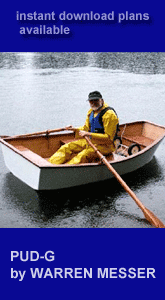I decided to build the Five Dollar Skiff drawn by "Paddlefast", who I think was Dan Beard, and published in the Scientific American in 1876. Why? Well because the design is 140 years old this year (I like old) and I could not find another built on the Internet and I should have. And, because the boat does not look like the one illustrated and I wanted to show how nice and simple its shape is. The sides are simply straight boards bent around a simple middle frame to create a nice shapely boat.
I came across the design here:
www.thecheappages.com/short/sci_am/skiff_1876.html
And, with a little searching, I found the original article online. The design is left of page. The rig is right of page. And, the reference to figure six is right of page. The alternative rig left of page.
 |
This is what the shape is said to look like. |
 |
This is the true shape. |
The main different between sketch of the boat and the real shape is the transom. It is more dory transom in shape.
The first task was deciphering the original article to make some notes. I found out the:
- Board in the water is 2' 8" x 14";
- Skeg 8" at transom;
- 2' tiller;
- Rudder is about 2' long and 12" high;
- Front seat 22" long, 3" down from sheer;
- Middle seat 7" down from sheer;
- Mast is 12" inches from the extreme bow;
- Pine mast is 11' 2" long and is 2.5" to 3" at the butt and 2" at the head;
- Mast step is 4" x 9" x 1.5" thick with a square socket 2" square;
- There is a small block at the top of the mast;
- Boom is about 2" thick mid point;
- Sprit is 12' long.
And there was a leg of mutton alternative rig:
- Length of sail should be about 13 feet on lower edge and 13 feet 8 inches height on mast;
- Length of mast, about 15 feet 9 inches.
Well that is what it was supposed to be.
On mine LOA is 11' 8-3/4", beam is 4' 1-1/4", depth midships is 11".
I chose to toss the old build method overboard and use modern materials. I used 1/4" plywood, the frames were 1 1/2 x 3/4" pine. The
chine logs internal 1 1/4x 3/4".
I am making it as a rowboat and a 2hp motorboat. Outboards were not even a twinkle in the captains eye in 1876.
I chose to make the hull in two sections to fit into my station wagon and I shortened the hull to about 11' 8" by shortening the sides from 12' 8" long to 12' long. The build method was the Bolger/Payson instant boat style along the method of Junebug.
I just built two middle frames and bolted them together. All 3/8 bolts and rubber washers. Two on the frame sides and two in the middle at the bottom. You need to drill bolt holes before you mount the frame in the boat. Not my idea, but you get an old inner-tube and cut out washers about 2" square. You then get two pieces of wood and place the rubber in a stack one on top of another between the wood. Then you just drill a 3/8" hole through the wood, rubber and all. Then you have rubber washers. I may put some rubber at the top of the seat to stop water coming up there as I think it did. This boat will spend most of it's days bolted together but if you need to bolt it and unbolt it a lot, make the boats easy to get at and it will make a spanner turn easier.
The bad news is I chose to build the two sections separately rather than build the boat in one piece and cut it in half. The boat does not really come together all that well in the mid-sections. It has a step, rather than a fair curve, in the bottom. The other issue is the chine logs created a hard spot on the ply.
 |
Hard spot on chine |
 |
Boat Henge |
 |
-s.jpg)
Ready for bolting |
 |

Not exactly a smooth curve in the bottom. |
The good news is it rows beautifully and effortlessly. It gets along very quickly and I am happy to bring a 140 year old drawing to life.
|













-s.jpg)
-s.jpg)






